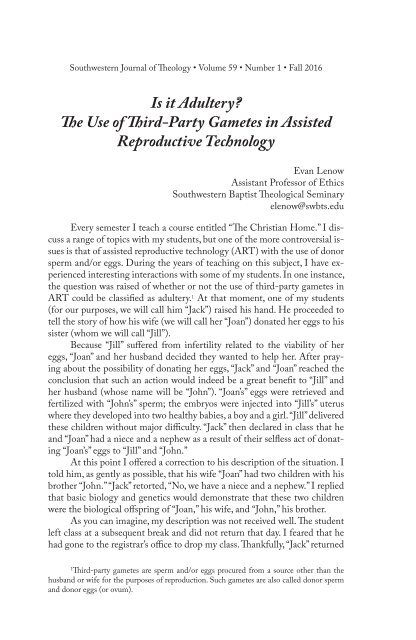experienced praying donating
SWJT%2059.1_Lenow
SWJT%2059.1_Lenow
You also want an ePaper? Increase the reach of your titles
YUMPU automatically turns print PDFs into web optimized ePapers that Google loves.
Southwestern Journal of Theology • Volume 59 • Number 1 • Fall 2016<br />
Is it Adultery?<br />
The Use of Third-Party Gametes in Assisted<br />
Reproductive Technology<br />
Evan Lenow<br />
Assistant Professor of Ethics<br />
Southwestern Baptist Theological Seminary<br />
elenow@swbts.edu<br />
Every semester I teach a course entitled “The Christian Home.” I discuss<br />
a range of topics with my students, but one of the more controversial issues<br />
is that of assisted reproductive technology (ART) with the use of donor<br />
sperm and/or eggs. During the years of teaching on this subject, I have <strong>experienced</strong><br />
interesting interactions with some of my students. In one instance,<br />
the question was raised of whether or not the use of third-party gametes in<br />
ART could be classified as adultery. 1 At that moment, one of my students<br />
(for our purposes, we will call him “Jack”) raised his hand. He proceeded to<br />
tell the story of how his wife (we will call her “Joan”) donated her eggs to his<br />
sister (whom we will call “Jill”).<br />
Because “Jill” suffered from infertility related to the viability of her<br />
eggs, “Joan” and her husband decided they wanted to help her. After <strong>praying</strong><br />
about the possibility of <strong>donating</strong> her eggs, “Jack” and “Joan” reached the<br />
conclusion that such an action would indeed be a great benefit to “Jill” and<br />
her husband (whose name will be “John”). “Joan’s” eggs were retrieved and<br />
fertilized with “John’s” sperm; the embryos were injected into “Jill’s” uterus<br />
where they developed into two healthy babies, a boy and a girl. “Jill” delivered<br />
these children without major difficulty. “Jack” then declared in class that he<br />
and “Joan” had a niece and a nephew as a result of their selfless act of <strong>donating</strong><br />
“Joan’s” eggs to “Jill” and “John.”<br />
At this point I offered a correction to his description of the situation. I<br />
told him, as gently as possible, that his wife “Joan” had two children with his<br />
brother “John.” “Jack” retorted, “No, we have a niece and a nephew.” I replied<br />
that basic biology and genetics would demonstrate that these two children<br />
were the biological offspring of “Joan,” his wife, and “John,” his brother.<br />
As you can imagine, my description was not received well. The student<br />
left class at a subsequent break and did not return that day. I feared that he<br />
had gone to the registrar’s office to drop my class. Thankfully, “Jack” returned<br />
1<br />
Third-party gametes are sperm and/or eggs procured from a source other than the<br />
husband or wife for the purposes of reproduction. Such gametes are also called donor sperm<br />
and donor eggs (or ovum).


